SEO for New Bloggers: 10 Essential Tips for 2024 Success

You pour your heart into a blog post, hit publish, and… nothing happens. I’ve been there, I published my first few posts without knowing anything about SEO. There was no traffic, no readers, and I was the only person visiting my blog.
My posts fell into the cracks of the internet. It was frustrating and made me question whether anyone would ever read my content. Sound familiar?
But don’t worry—you’re not alone. I’ve gone through the trial and error of best SEO practices and have created a guide on SEO for new bloggers.
The good news is that Search Engine Optimization is about to become your secret weapon. It looks like tech jargon but playing the game of SEO is easier than you think.
It is the bridge that connects your ideas to the people who are actively searching for them.
So, in this guide, we’ll explore 10 essential tips to help your blog to get search engine rankings and reach your target audience. I will help you avoid pitfalls and fast-track your success.
You’ll learn:
- Boost your rankings with SEO best practices
- Do keyword research to attract the right audience
- Write SEO-friendly content that search engines love
- Boost your blog’s performance by doing Technical SEO
- Build high-quality backlinks to increase your rankings
Mastering SEO is crucial if you’re starting your blog, so let’s get into the SEO lessons!
Understanding The Basics Of SEO For New Bloggers
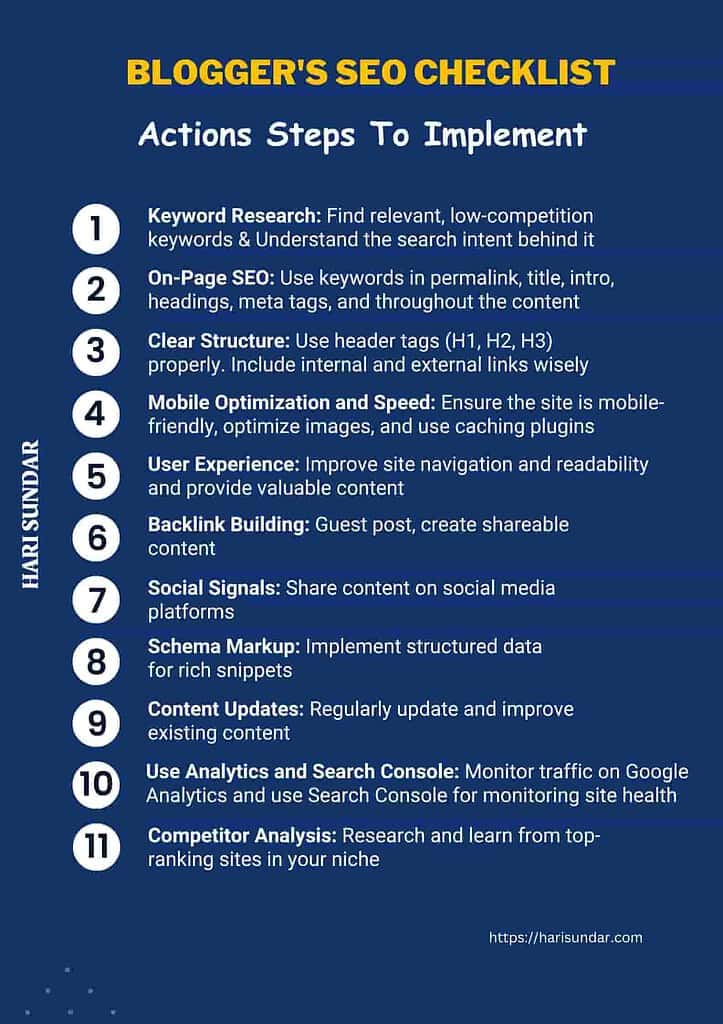
Research shows more than 68% of online experiences begin with a search engine. That’s true! You will lose a huge portion of your potential readers if you fail to optimize your blog for search engines.
SEO helps your blog’s visibility to the right people at the right time. It’s all about making your content irresistible to both search engines and readers.
As I said in the introduction, I had no clue about SEO when I started. My posts were barely noticed and quickly forgotten.
So, how do search engines work their magic? Think of them as experienced librarians. They first crawl the web, scan through the contents, and categorize them (we call it indexing).
And then deciding which pages to show for specific searches (ranking). It’s a complex process, but understanding how search engines work can give your blog a serious edge.
Now, let’s break down SEO into two main types: on-page and off-page. On-page SEO is simply like what is on the page.
It is optimizing your content, headings, and images with the right keywords. You control what should be on your content.
On the other hand, off-page SEO is building your blog’s reputation through backlinks and social signals. I will cover both on-page and off-page SEO in the upcoming sections.
Now, let’s discuss why topical authority is important for your blog. Because search engines are getting smarter and smarter, now they are better at picking user signals.
So, it is not just about writing blog posts around some low-hanging keywords only based on data. It is about building a foundation for your blog and providing value to people.
They both want to see that you’re a true expert in your field. As a new blogger, focusing on building topical authority is crucial.
It’s like becoming the go-to person for a specific topic – the more you know, the more people (and search engines) trust you.
I made the mistake of not focusing on topical authority from the beginning. I wrote blog posts based on search volume and low-difficulty keywords without building a foundation.
After learning the importance of topical authority, I focused more on one area in digital marketing than on writing random posts.
I chose blogging, covering all the aspects of blogging, and then moved to other areas in digital marketing.
So what should you do?
Let’s say your niche is health, then niche down further to individual sub-niches. Start with a sub-niche within your broader niche, health. Write articles until your topical authority is established in the sub-niche.
Note that, the more competitive the niche is, the more articles you need to create to become a go-to expert.
And then, you can expand it to other sub-niches within your broader niche. I will explain more about this in the next section.
Why is all this SEO stuff so important for new bloggers? Simple – visibility. Without SEO, you are locking your brilliant blog posts in a dusty drawer.
Also, other than SEO, there’s another factor to establish your topical authority faster. It is choosing the right blog niche. Your niche should align with your expertise and interests making it easier to build topical authority.
Write for people and then optimize for search engines. Create valuable content that solves your readers’ problems.
So, start by focusing on one sub-niche first within your main niche, create in-depth content around it, and watch your blog’s visibility grow.
In the next section, we’ll explore the foundation of blog SEO – keyword research. Get ready to uncover the exact phrases your future readers are searching for!
Keyword Research: The Foundation of Blog SEO
Did you know that around 75% of users never scroll past the first page of search results?
That’s why keyword research is the backbone of successful blog SEO. It’s how you figure out what your audience is searching for.
Keywords are the phrases people type into search engines. They’re bridges connecting with readers who are looking for exactly what you’re writing about.
One target keyword is for one blog post. Don’t use the same target keyword for writing multiple blog posts.
Because search engines get confused about which post to rank for the same keyword and thus it affects SEO.
When I started blogging, I thought I could just write about whatever popped into my head. That is what I did with my old blog.
Big mistake! I learned quickly that understanding keywords is crucial for getting my content seen.
So, how do you find the right keywords for your blog? Here’s a simple process:
- Brainstorm topics related to your niche
- Use tools like Ahrefs (paid) or Google Keyword Planner (free) to do keyword research
- Use Google’s autocomplete feature to expand on these ideas
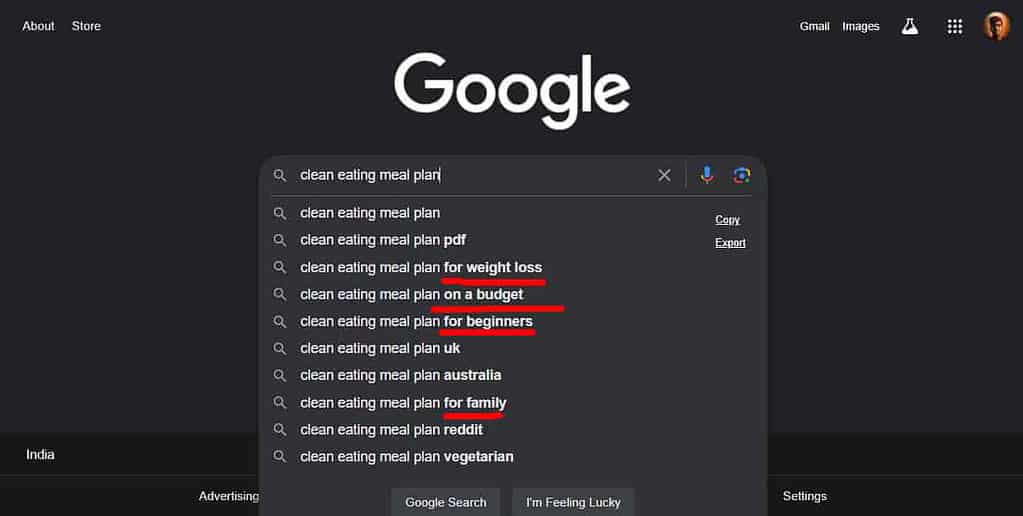
- Check out the “People Also Ask” sections for related questions
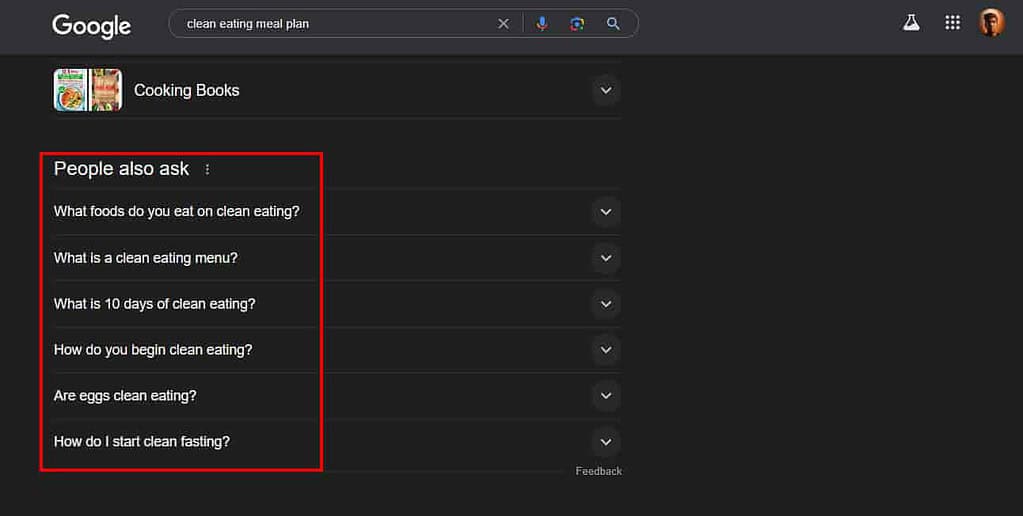
- Analyze your competitors’ content and do a content gap analysis for keyword inspiration
Let’s take the same example, your health niche. To establish your topical authority, don’t write one post on nutrition and another on mindfulness.
They may get lost in the big ocean of health blogs. Because they are different sub-topics within your health niche.
As I said, start with one sub-niche. See the examples of sub-niches for health below:
Sub-niche 1: Nutrition and diet
Sub-niche 2: Mental health and wellness
Sub-niche 3: Fitness and exercise
Sub-niche 4: Alternative medicine and holistic health
Sub-niche 5: Men’s Health/Women’s health
Instead of targeting the broader Health niche, start with a sub-niche “Nutrition and diet”. So, that you’ll have a more focused approach and attract more qualified traffic.
But remember that you should not be too narrow, pigeonholing yourself. Choose a sub-niche that has the potential to write at least 20 articles.
To build topical authority, focus on keyword clusters. These are groups of related keywords that cover different aspects of a topic.
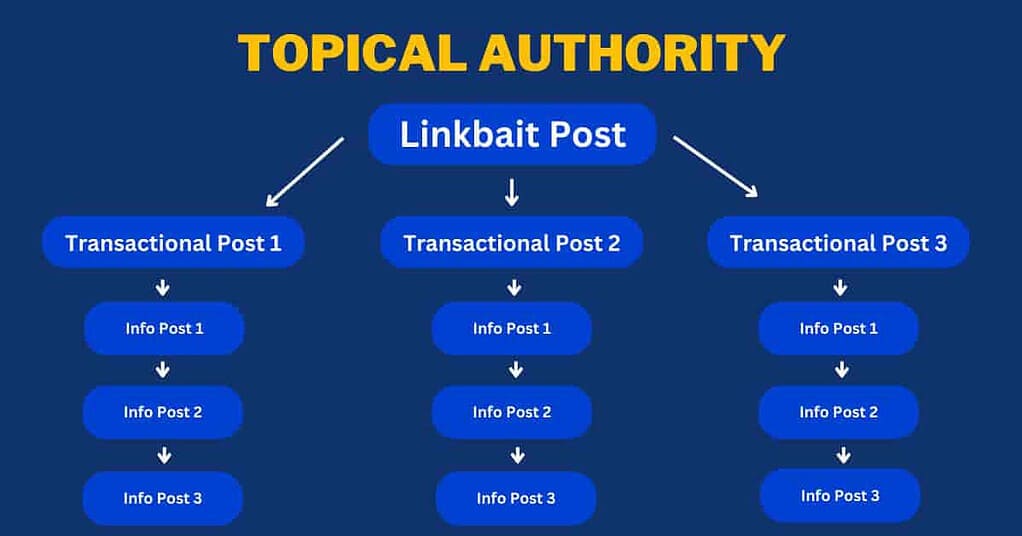
Let’s take the sub-niche ‘Nutrition and diet’, the keyword clusters might include:
| SEO-friendly Article Title | Target Keyword |
| 1. 10 Easy Mediterranean Diet Recipes for Beginners | mediterranean diet recipes |
| 2. The Ultimate Guide to Counting Macros for Weight Loss | macro counting for weight loss |
| 3. 7-Day Clean Eating Meal Plan for Busy Professionals | clean eating meal plan |
| 4. How to Read Nutrition Labels: A Step-by-Step Guide | how to read nutrition labels |
| 5. The Truth About Detox Diets: Do They Really Work? | do detox diets work |
| 6. Review: 5 Popular Nutrition Tracking Apps Compared | best nutrition tracking apps |
| 7. Honest Review: Are Weight Loss Meal Delivery Services Worth It? | weight loss meal delivery services review |
By creating content around these clusters, you signal to search engines that you’re a resource on the topic.
Free tools can supercharge your keyword research, I started with free tools. Google Keyword Planner shows you search volumes and competition levels.
AnswerThePublic comes with questions people are asking about your topic. I use these questions for my FAQ sections. These tools helped me cover in-depth topics and boosted my blog’s visibility.
As a beginner, to do keyword research, look for low-difficulty keywords with a good search volume (say 250-350/month).
I recommend you go with long-tail keywords. They’re longer, more specific phrases that might have lower search volumes but are easier to rank for. But don’t forget to build your foundation to increase your topical authority.
Now that you’ve got your keyword strategy down and you have a handful of keywords. But, how do you use these phrases in your content naturally without keyword stuffing? Let’s see that!
On-Page SEO Techniques for Blog Posts
SEO experts believe the title tag is the most important on-page SEO element. It’s true! Because a title is the first thing that a user sees.
On-page SEO is where the rubber meets the road in your blogging journey. As we discussed, it’s how you tell search engines, “Hey, this is what my content is all about!”
Let’s start with title tags and meta descriptions. These are your blog post’s first impressions in search results. Here’s how to nail them:
- Include your target keyword in the title tag
- Keep titles under 60 characters to avoid truncation
- Include the target keyword in the meta description and make it a compelling 150-160 character summary
- You can also include a call-to-action in your meta description
For example, if you are writing for the target keyword: “clean eating meal plan”
A good title might be: “7-Day Clean Eating Meal Plan for Busy Professionals”
A good meta description under 155 characters might be:
“Discover our simple 7-day clean eating meal plan tailored for busy professionals. Save time and boost energy. Start your healthy journey today!”
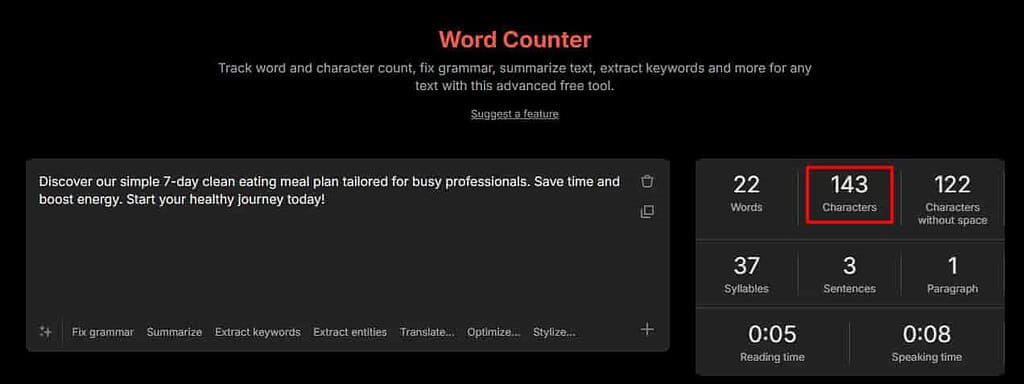
Now, let’s talk about incorporating keywords in other areas of the content. The key is to sound natural. Don’t force it!
Where you should include the keywords?
- In the permalink
- In the introduction (in 1st or 2nd paragraph)
- In H2, H3 headings, and
- Throughout the post, but be natural and don’t stuff it.
For instance, this blog post uses all the keywords naturally without feeling forced. I have used the target keyword “SEO for new bloggers” and the semantic keywords throughout this blog post.
Semantic keywords are related to a target keyword or topic. Search engines use these semantic keywords to understand the context behind the content.
It enables them to provide accurate results that match the user’s search query. Semantic keywords are also known as latent semantic indexing (LSI) keywords.
For example, if you’re writing about a beach in India, search engines would look for keywords that are related to the beach. The semantic keywords might be sand, beach ball, restaurants, seafood, boating, etc.
What about links? Incorporating relevant links is like building a web of credibility. We have two types of links in on-page SEO. One is the internal link and the other is the external link.
Internal links guide readers to your other relevant content, keeping them on your site longer.
External links to high-authority sources back up your claims and show search engines you’re part of a larger conversation.
For both links, you need to optimize your anchor text for more engagement. Just make sure these links open in a new tab so you don’t lose your dwell time.
Now, let’s look at images.
Images are often overlooked in SEO, but they’re crucial. Here’s how to optimize them:
- Use descriptive file names (e.g., “clean-eating-meal-plan.jpg” instead of “IMG_1234.jpg”)
- Add alt text that describes the image and includes your keyword if relevant
- Compress images to improve page load speed
For example, an alt text might be:
“7-day clean eating meal plan with colorful, balanced meals for busy professionals”
I remember my first few posts, I’d stuff keywords everywhere thinking it would help, but it didn’t. It made my content read like a robot wrote it. Don’t make the same mistake!
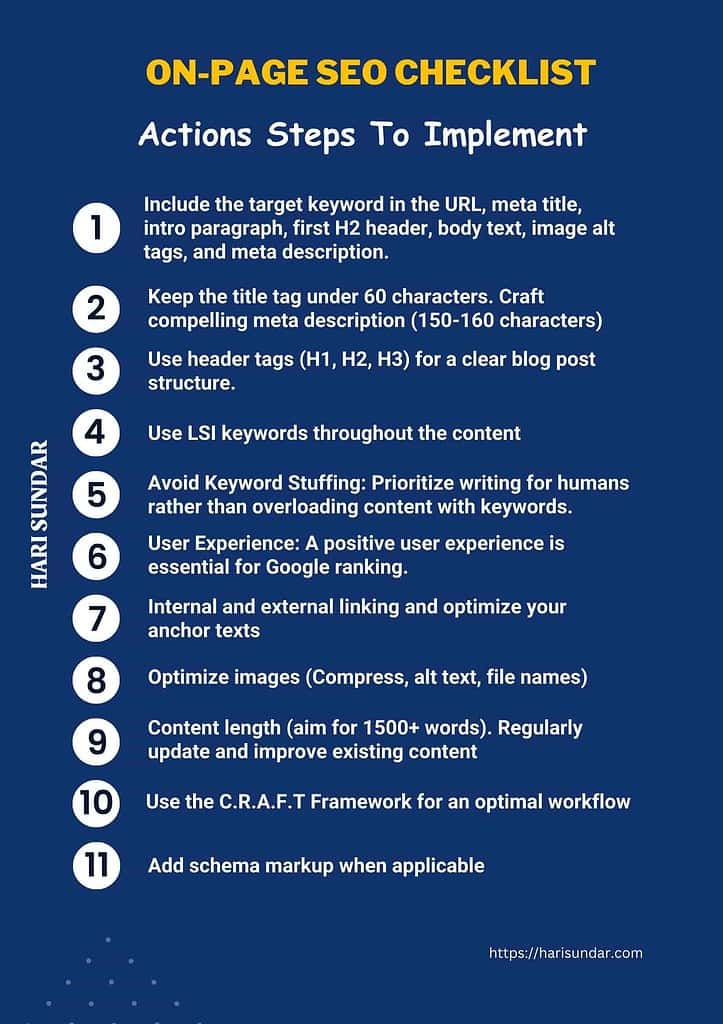
Congrats! You’ve learned about on-page SEO. But how do you create content that’s not only SEO-friendly but also keeps readers coming back for more?
Great question! Let’s take your blog posts from good to great.
Creating SEO-Friendly Content That Readers Love
Want to know the secret to content that ranks and resonates? It’s all about creating SEO-friendly and high-quality content that readers love. Nothing else other than providing value to your audience.
When I first started, I made the mistake of rehashing what everyone else was saying. I provided the same commodity content without adding any unique value to my readers.
Content with a high level of topical depth gets 56% more engagement than shorter, surface-level pieces.
It wasn’t until I started sharing unique insights and personal experiences that my blog took off. Readers crave authenticity and fresh perspectives.
You should structure your blog posts for both readability and SEO. Here’s a simple framework:
- Start with a good title and compelling introduction that draws the target reader in
- Header tags are your content’s roadmap. Think of it like chapters and subchapters in a book. Use them to structure your post logically
- H1: Your main title (use only once)
- H2: Major sections of your content
- H3: Subsections within your H2s
- H4: Subsections within your H3s
- Keep paragraphs short (2-3 sentences max)
- Include bullet points or numbered lists for easy scanning
- Articles with images get 94% more views than those without. Here’s how to effectively use multimedia:
- Include relevant images, infographics, or charts
- Add alt text to all visuals for SEO and accessibility
- Embed videos to explain complex concepts
- Create interactive elements like quizzes or polls
- Also, you can use the C.R.A.F.T. Framework for a good workflow:
- Cut: Remove unnecessary content.
- Review: Evaluate and optimize for both humans and SEO.
- Add: Include images and other media.
- Fact-check: Verify the accuracy of the content.
- Ensure: Maintain trustworthiness, a personal touch, and an appropriate tone.
- Include relevant internal and external links and optimize the anchor text
- End with a strong conclusion and call to action
- Include a FAQ section if needed.

This structure helps readers navigate your content and reduces the bounce rate. It also signals to search engines the hierarchy of information in your post.
Remember, the goal is to create content that ranks well and also provides real value to your readers. It’s this combination that will keep them coming back for more.
But, how do you ensure your blog is set up for SEO success from the ground up? That’s exactly what we’ll explore in the next section on technical SEO basics.
Technical SEO Basics for Your Blog
Did you know that 47% of users expect a website to load in 2 seconds or less? Technical SEO might sound intimidating, but it’s crucial for your blog’s success.
It’s like the engine of your car – you don’t need to be a mechanic, but you should know the basics to keep things running smoothly.
Let’s start with choosing an SEO-friendly blogging platform. I started with Blogger and it limited my SEO capabilities. Big oops!
After some trial and error, I found that the self-hosted WordPress platform is great to go. WordPress is my personal favorite for its flexibility, customization, and robust SEO plugins.
Optimizing your blog’s loading speed is non-negotiable. Here are some quick wins:
- Compress images before uploading
- Use a caching plugin, free options include the W3 Total Cache plugin
- Minimize redirects
- Enable browser caching
- Use a content delivery network (CDN)
Tools like Google PageSpeed Insights can help you identify and fix speed issues.
Mobile-friendliness is another crucial factor. With over 50% of web traffic coming from mobile devices, Google now uses mobile-first indexing.
This means they primarily use the mobile version of your site for ranking and indexing. Ensure your blog theme is responsive and test it on various devices.
Now, let’s talk about XML sitemaps and robots.txt files. These are like roadmaps for search engines.
An XML sitemap lists all your important pages, helping search engines crawl your site more efficiently. Most SEO plugins can generate this for you automatically.
The robots.txt file tells search engines which parts of your site to crawl and which to ignore. It’s particularly useful for preventing duplicate content issues.
Here’s a basic example:
User-agent: * Disallow: /wp-admin/ Allow: /wp-admin/admin-ajax.php
This tells all search engines not to crawl your WordPress admin area but allows access to admin-ajax.php, which is necessary for some functionalities.
Remember, technical SEO is an ongoing process. Regular audits can help you catch and fix issues before they impact your rankings.
Now let’s get into building backlinks for your blog – doing off-page SEO to expand your blog’s reach.
Building Backlinks: Off-Page SEO for New Bloggers
Imagine your blog is a party. On-page SEO gets people through the door, but backlinks? They’re the cool kids telling everyone your party is the place to be.
Pages with a high number of backlinks rank higher compared to those without backlinks.
Backlinks are like votes of confidence from other websites. But high-quality backlinks aren’t handed out like free samples at the grocery store.
You’ve got to earn them by creating content so good that other sites want to link to it. It’s a value exchange – you provide killer content, and they provide a backlink.
For new bloggers, here are some safe and effective link-building strategies:
- Create compelling, link-bait content
- Reach out to industry experts for quotes
- Develop infographics or original research
- Participate in relevant online communities
Guest posting is another powerful technique. Here’s how to do it right:
- Find blogs in your niche accepting guest posts
- Study their content and guidelines
- Pitch unique, valuable ideas
- Write high-quality, original content
- Include a natural link back to your site in the bio or content
Don’t forget about social media. Different platforms work better for different niches:
- LinkedIn: Great for B2B, marketing, and professional topics
- Instagram: Perfect for visual-heavy niches like food, travel, or fashion
- X Platform (formerly Twitter): Ideal for news, tech, and quick-hit content
- Pinterest: Excellent for DIY, recipes, and home decor
- TikTok: Fantastic for reaching younger audiences with quick, engaging content
Choose the platform where your audience hangs out. For instance, if you’re blogging about business strategies, LinkedIn might be your goldmine.
Building backlinks is a marathon, not a sprint. Focus on creating value, and the links will follow.
In the next section, we’ll dive into measuring your SEO success with analytics. Ready to crunch some numbers?
Measuring Your SEO Success with Analytics
You wouldn’t drive blindfolded, right? So why blog without analytics?
A staggering 90% of bloggers who use analytics report better results. It’s like having a GPS for your blog’s journey to SEO success.
First things first: set up Google Analytics and Search Console. They’re free and powerful tools that give you a wealth of information about your blog’s performance.
Now, let’s talk about key metrics. Here are the big ones to watch:
- Organic traffic: How many visitors come from search engines?
- Bounce rate: Are people sticking around or leaving quickly?
- Average time on page: How long are they reading?
- Conversion rate: Are they taking desired actions (subscribing, buying, etc.)?
- Keyword rankings: Which search terms are you ranking for?
These KPIs help you understand analytics and audience insights, guiding your content strategy.
The bounce rate is a tricky one. A high bounce rate isn’t always bad, but if it’s consistently above 70%, you might have a problem. Here’s how to improve it:
- Make sure your content delivers on your title’s promise
- Improve your page load speed
- Use internal links to guide readers to related content
- Break up text with subheadings, images, and bullet points
- End posts with a clear call-to-action
Data is useless if you don’t act on it. Use your analytics to refine your SEO strategy:
- Identify your top-performing posts and create similar content
- Find low-hanging fruit – keywords you’re ranking on page 2 for – and optimize those posts
- Spot trends in topics your audience engages with most
- Use demographic data to tailor your content to your actual audience
- Track which sources bring the most valuable traffic and focus your efforts there
When I started using data to guide my decisions, I saw more impressions and clicks in just three months.
Now you might be thinking, “Great, but what pitfalls should I watch out for?” Come on, we’ll explore that. Ready to learn from others’ errors? That includes mine too!
Common SEO Mistakes New Bloggers Make (And How to Avoid Them)
Want to know the quickest way to tank your blog’s SEO? Make these common mistakes! I’ve seen countless new bloggers (including myself) slip into these pitfalls. But don’t worry, I’ll show you how to sidestep them.
First up: keyword stuffing. It’s tempting to insert your target keyword into every other sentence, but that’s a surefire way to turn off both readers and search engines.
Instead, focus on creating valuable, natural-sounding content. Use synonyms and related terms. Remember, Google’s pretty smart these days – it understands context.
Mobile optimization is non-negotiable. With over 50% of web traffic coming from mobile devices, ignoring mobile users is like turning away half your potential audience. Make sure your blog theme is responsive and test it on various devices.
Site speed and user experience go hand in hand. A slow-loading site is the digital equivalent of a yawn – it’ll send visitors running.
Optimize your images, use a good hosting provider, and keep your design clean and intuitive. I once cut my load time in half by simply compressing my images!
Lastly, don’t let your old content gather dust. Regularly updating and refreshing your posts keeps them relevant and can give them a nice SEO boost.
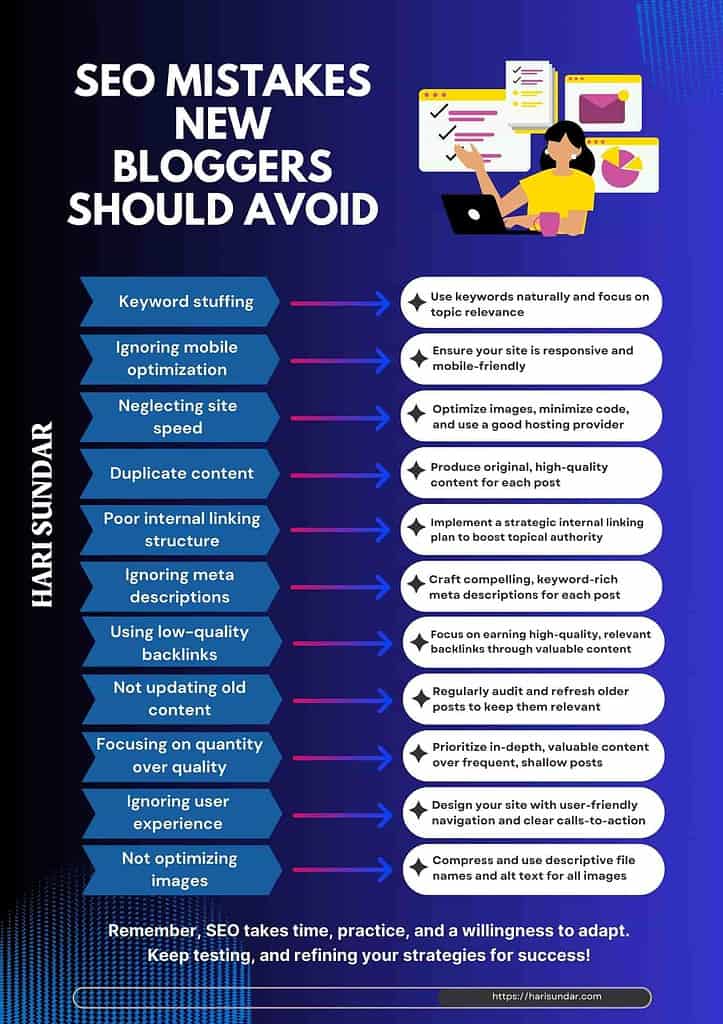
Avoiding these mistakes will put you ahead of the game. But what if you want to stand out? That’s where advanced SEO techniques come in.
Let’s dive into some pro strategies!
Advanced SEO Techniques to Explore as You Grow
These advanced techniques can boost your blog’s visibility and establish you as an authority in your niche. I’ve seen my traffic double after implementing some of these strategies!
Let’s start with schema markup. It’s like giving search engines a cheat sheet for your content. Here’s how to implement it:
- Choose the appropriate schema type for your content
- Use Google’s Structured Data Markup Helper to generate the code
- Test your markup with the Rich Results Test tool
- Add the generated code to your page’s HTML
Voice search is booming, with around 41% of adults using voice search daily. To optimize for it:
- Focus on natural, conversational language
- Target question-based keywords (who, what, when, where, why, how)
- Create FAQ pages addressing common queries in your niche
- Aim for featured snippets, which often become voice search results
Pillar content and topic clusters are powerful for building topical authority. Here’s how to create effective clusters:
- Identify a broad topic relevant to your sub-niche within your niche
- Create a comprehensive pillar page on that topic
- Develop multiple related subtopic posts
- Link subtopic posts to the pillar page and vice versa
- Regularly update and expand your cluster content
- Then move to other sub-niches
For location-specific blogs, local SEO is crucial. Try these tactics:
- Claim and optimize your Google My Business listing
- Include location-based keywords in your content
- Get listed in local directories and citation sites
- Encourage and respond to customer reviews
- Create location-specific landing pages if you serve multiple areas
These advanced techniques can significantly boost your blog’s SEO performance. But with search engines constantly evolving, how do you stay ahead of the curve?
In our final section, I will teach how to keep up with SEO trends and algorithm changes. Ready to future-proof your blog?
Staying Up-to-Date with SEO Trends and Algorithm Changes
Did you know Google updates its algorithm hundreds of times a year? Staying on top of SEO trends isn’t just smart – it’s essential.
I learned this the hard way when an algorithm update uprooted my traffic overnight. I think that was in 2023 by the Helpful Content Update. Don’t make my mistake!
First, follow reputable SEO blogs and resources. My go-to’s are Moz, Search Engine Journal, and Google’s Search Central Blog.
These keep you informed without drowning you in techno-babble. Set up an RSS feed or subscribe to their newsletters to get updates straight to your inbox.
Understanding major Google algorithm updates is crucial. Each update has a focus:
- Panda: Content quality
- Penguin: Link quality
- Hummingbird: Natural language processing
- BERT: Context understanding
But now the major updates are known as core updates. When an update hits, don’t panic. Instead, analyze your traffic and rankings, then adjust your strategy accordingly.
Adapting to evolving best practices is key to overcoming blogging challenges. Here’s how to stay adaptable:
- Regularly audit your site
- Test new SEO techniques on a small scale
- Keep user experience at the forefront
- Be willing to pivot your strategy
Continuous learning in SEO and your niche is non-negotiable. Set aside time each week to read industry news, take online courses, or attend webinars.
I dedicate 2 hours every week to this, reading industry publications, and it’s paid off big time.
You’ve now got a solid foundation in SEO. But here’s the million-dollar question: how do you take all this knowledge and turn it into a concrete action plan for your blog?
Let’s get to the conclusion part, where I’ll tie everything together and get you ready to skyrocket your blog’s SEO!
Conclusion
Congratulations! You’ve just gotten a crash course in SEO for new bloggers. Remember, SEO isn’t just about algorithms – it’s about serving your audience better.
SEO journey as a new blogger might feel daunting, but remember – every expert was once a beginner.
As you grow your SEO skills, you’re also deepening your expertise in your niche. This combo is pure gold for your blog’s success.
Now, let’s turn all this knowledge into action. Here’s your concrete plan to boost your blog’s SEO:
- Choose your niche and learn to blog effectively within it
- Set up Google Analytics and Search Console to track your progress
- Conduct keyword research and create a content calendar
- Optimize your on-page SEO (titles, meta descriptions, headers, etc.)
- Create high-quality, original content that serves your audience
- Implement technical SEO basics (mobile optimization, site speed, etc.)
- Start building backlinks through guest posting and collaboration
- Regularly analyze your performance and adjust your strategy
- Stay updated with SEO trends and algorithm changes
- Continuously learn and experiment with advanced SEO techniques
Don’t get discouraged if you don’t see results overnight. Great things take time.
Be patient, stay consistent, and keep creating valuable content for your readers. With time and effort, you’ll see your blog climb those search rankings.
So, what’s your first step going to be? Will you start with keyword research, or dive into optimizing your existing content?
Whatever you choose, take action today. Your future readers are out there, searching for exactly what you have to offer. It’s time to help them find you!
FAQs: SEO For New Bloggers
Is SEO necessary for new bloggers?
Absolutely! SEO helps your blog get found by people searching for your content. Without it, your posts might never reach your target audience. It’s like having a great shop but forgetting to put up a sign – SEO is that sign for the digital world.
How long does it take to see results from SEO?
SEO is a long-term game. You might see some improvements in a few months, but significant results often take 6-12 months. Don’t get discouraged! Keep creating quality content and optimizing consistently. The results are worth the wait.
What’s the most important SEO factor for bloggers?
High-quality, original content is king. Focus on creating valuable posts that answer your audience’s questions. Use relevant keywords naturally, optimize your titles and meta descriptions, and make sure your content is easy to read and share.
Do I need to pay for SEO tools as a new blogger?
Not necessarily. While paid tools can be helpful, there are many free options to start with. Google Analytics, Google Search Console, and Keywords Everywhere are great free tools. As you grow, you can consider investing in paid tools.
How often should I update my blog for SEO?
Aim to publish new content regularly, at least once a week if possible. Also, update your existing posts periodically. Fresh content signals to search engines that your site is active and relevant, which can boost your rankings.
Can I do SEO myself, or should I hire an expert?
As a new blogger, you can handle basic SEO yourself. Start with the fundamentals we’ve covered here. As your blog grows, you might consider hiring an expert for more advanced strategies, but it’s not necessary when you’re just starting.
What’s the biggest SEO mistake new bloggers make?
Keyword stuffing is a common mistake. Don’t unnaturally overuse keywords. Focus on writing for your readers first, then optimize for search engines. Natural, engaging content always performs better than forced, keyword-heavy text.





